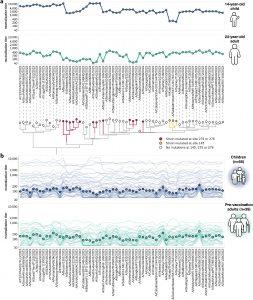Influenza viruses constantly mutate, allowing them to evade immune defences developed from previous infections or vaccinations. As a result, flu infections are recurrent, and vaccine formulations must be updated regularly. However, each person’s immune history—shaped by the particular strains they’ve encountered—varies widely, influencing their susceptibility to future infections.
A new study describes on how differences in individual immune responses influence which flu strains take hold in a population (Figure 1). Using an innovative high-throughput assay, scientists have demonstrated that person-to-person variation in antibody levels—not just average population immunity—plays a major role in determining which influenza variants spread most successfully.

Figure 1: Neutralization titers to 2023-circulating strains for children and adults vary among individuals and cohorts. (a) Neutralization titer profiles for a child and a pre-vaccination adult, showing the titer of each serum against each of the 2023-circulating strains in the library. Neutralization by the child’s serum is reduced for strains with the S145N mutation in antigenic region A, while neutralization by the adult’s serum is reduced by multiple mutations within antigenic region C (sites 275 and 276). Strains are grouped phylogenetically on the X-axis. (b) Neutralization titer profiles across all individuals from the children and adult pre-vaccination cohorts. Each thin line is a neutralization titer profile for an individual serum. Each point represents the median neutralization titer across all sera for that strain.
The study presents compelling evidence that variation in antibody immunity across individuals can shape the evolutionary path of the influenza virus, particularly the H3N2 subtype. This work provides critical insights for immunologists, virologists, and vaccine developers aiming to stay ahead of one of the fastest-evolving human pathogens.
To overcome this challenge, they developed a high-throughput neutralization assay capable of rapidly quantifying antibody responses across many individuals and virus variants simultaneously. The team then analysed how this variation correlates with the success of flu strains in the real world.
The researchers engineered 78 influenza viruses, each displaying a distinct hemagglutinin (HA) protein—a viral surface protein targeted by antibodies. By tagging each variant with a unique genetic barcode, they were able to track how well individual serum samples could neutralize each strain using Illumina sequencing.
The results revealed substantial variation. Some children’s serum samples strongly neutralized most strains, while others showed weak or uneven responses. Adults, though generally more consistent, also exhibited a wide range of neutralizing capacity. Interestingly, the most potent neutralization responses were often found in subsets of children—potentially due to recent exposures or early-life encounters with similar strains.
The researchers then asked how this variation influences which flu strains thrive. Using a statistical model (multinomial logistic regression), they compared each strain’s growth over the 2023 season to the proportion of serum samples that had weak neutralization against it.
The finding was clear: flu strains that escaped neutralization in a larger share of individual samples were more likely to spread. In other words, individual-level immune gaps—rather than averaged immune responses—better predicted which variants would dominate.
Importantly, this effect disappeared when serum samples were pooled together, a common practice in some surveillance systems. This suggests that pooled antibody measurements may obscure critical variability in immune protection across individuals, potentially limiting their predictive power.
As flu viruses continue to evolve, tools like this high-throughput assay may become essential for anticipating which strains are likely to gain a foothold—and for tailoring vaccines to meet the shifting landscape of immunity within the population.
Journal article: C. Kikawa et al. High-throughput neutralization measurements correlate strongly with evolutionary success of human influenza strains. eLife.
Summary by Stefan Botha










